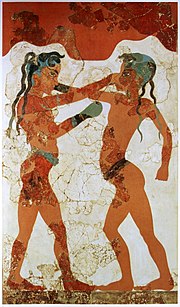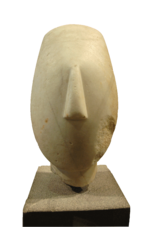Minoan art is the art produced by the Bronze Age Aegean Minoan civilization from about 3000 to 1100 BC, though the most extensive and finest survivals...
62 KB (7,816 words) - 12:54, 4 June 2024
The Minoan civilization was a Bronze Age culture which was centered on the island of Crete. Known for its monumental architecture and energetic art, it...
116 KB (13,771 words) - 00:06, 6 July 2024
The Minoan civilization in the Bronze Age (c. 3500–1100 B.C.E) was located on the island of Crete. Focusing on the palatial periods between c. 1900 and...
4 KB (548 words) - 14:48, 16 February 2024
The Minoan civilization produced a wide variety of richly decorated Minoan pottery. Its restless sequence of quirky maturing artistic styles reveals something...
43 KB (4,416 words) - 22:15, 5 July 2024
materials produced in the Minoan civilization. They are an important part of Minoan art, and have been found in quantity at specific sites, for example in Knossos...
10 KB (1,397 words) - 23:04, 15 June 2024
Two Minoan snake goddess figurines were excavated in 1903 in the Minoan palace at Knossos in the Greek island of Crete. The decades-long excavation programme...
20 KB (2,443 words) - 11:37, 2 May 2024
The Minoan Genius is a legendary creature that was common in the Minoan art of the Bronze Age Minoan civilization in ancient Crete. It is portrayed sometimes...
6 KB (696 words) - 17:14, 6 November 2023
Minoan palaces were massive building complexes built on Crete during the Bronze Age. They are often considered emblematic of the Minoan civilization and...
42 KB (5,130 words) - 15:02, 30 May 2024
Minoan religion was the religion of the Bronze Age Minoan civilization of Crete. In the absence of readable texts from most of the period, modern scholars...
33 KB (4,575 words) - 12:04, 5 July 2024
Cycladic and Minoan cultures, which converged over time. Cycladic art is known for its simple figurines carved in white marble; Minoan art for its palace...
11 KB (1,421 words) - 21:11, 30 May 2024
Cleveland Museum of Art (Ohio, US) The Minoan civilization of Crete is regarded as the oldest civilization in Europe. Minoan art is marked by imaginative...
70 KB (8,178 words) - 18:50, 29 April 2024
Bull-Leaping Fresco (category Minoan frescos)
Late Minoan (LM) II. By that time the east stairwell, near which they fell, was disused, being partly ruinous. The subject is common in Minoan art, one...
14 KB (1,544 words) - 18:13, 27 May 2024
Poppy goddess (category Minoan art)
example of a distinctive type of large female terracotta figurine in Minoan art, presumably representing a goddess, but not thought to be cult images...
6 KB (730 words) - 02:29, 8 April 2024
Western art history. An art period is a phase in the development of the work of an artist, groups of artists or art movement. Minoan art Aegean art Ancient...
10 KB (960 words) - 16:21, 29 June 2024
The Minoan Moulds of Palaikastro (Greek: Μήτρες του Παλαιοκάστρου Σητείας, romanized: Mitres tou Palaiokastrou Sitias) are two double-sided pieces of schist...
15 KB (1,464 words) - 20:05, 17 February 2024
Bull-leaping (category Minoan religion)
bulls is a motif in Middle Bronze Age figurative art, especially in Minoan art, and what are probably Minoan objects found in Mycenaean Greece, but it is...
11 KB (1,401 words) - 04:58, 22 July 2024
Tell el-Dab'a (category Minoan art)
Dynasty (early second millennium BC). The site is known primarily for its Minoan frescoes. Excavations in the area were started in 1885 by Édouard Naville...
14 KB (1,817 words) - 19:53, 30 March 2024
Hagia Triada Sarcophagus (category Minoan art)
The Hagia Triada Sarcophagus is a late Minoan 137 cm (54 in)-long limestone sarcophagus, dated to around 1400 BC or some decades later, excavated from...
16 KB (2,225 words) - 12:29, 3 March 2024
The Minoan eruption was a catastrophic volcanic eruption that devastated the Aegean island of Thera (also called Santorini) circa 1600 BCE. It destroyed...
78 KB (8,129 words) - 20:56, 14 July 2024
Pylos Combat Agate (category Minoan art)
The Pylos Combat Agate is a Minoan sealstone of the Mycenaean era, likely manufactured in Late Minoan Crete. It depicts two warriors engaged in hand-to-hand...
11 KB (1,081 words) - 09:47, 22 June 2024
Knossos (category Minoan sites in Crete)
Bronze Age archaeological site in Crete. The site was a major center of the Minoan civilization and is known for its association with the Greek myth of Theseus...
47 KB (5,507 words) - 15:37, 22 July 2024
Vaphio (category Minoan art)
Museum of Athens, where many remain on display. Many are regarded as Minoan art, while others are thought to have been made on mainland Greece. The pottery...
7 KB (972 words) - 20:30, 30 October 2023
best in the world for Minoan art, as it contains by far the most important and complete collection of artefacts of the Minoan civilization of Crete....
12 KB (1,232 words) - 18:34, 30 May 2024
Wall Paintings of Thera (category Minoan frescos)
the Greek island of Santorini (or Thera). They are regarded as part of Minoan art, although the culture of Thera was somewhat different from that of Crete...
5 KB (598 words) - 20:45, 17 February 2024
Malia Pendant (category Minoan art)
found in a tomb in 1930 at Chrysolakkos, Malia, Crete. It dates to the Minoan civilization, 1800-1650 BC. The pendant was excavated by French archaeologists...
7 KB (806 words) - 21:37, 23 June 2024
Cycladic art The ancient Cycladic culture flourished in the islands of the Aegean Sea from c. 3300 to 1100 BCE. Along with the Minoan civilization and...
21 KB (2,468 words) - 19:02, 11 June 2024
Hellenistic art Hellenistic art is the art of the Hellenistic period generally taken to begin with the death of Alexander the Great in 323 BC and end with...
76 KB (8,612 words) - 23:35, 9 June 2024
Labrys (category Minoan art)
In ancient Crete, the double axe was an important sacred symbol of the Minoan religion. In Crete the double axe only accompanies goddesses, never gods...
26 KB (2,402 words) - 22:34, 3 June 2024
Arkalochori Axe (category Minoan art)
The Arkalochori Axe is a 2nd millennium BC Minoan bronze votive double axe (labrys) excavated by Spyridon Marinatos in 1934 in the Arkalochori cave in...
5 KB (272 words) - 12:21, 1 March 2024
Gold grave goods at Grave Circles A and B (category Minoan art)
late Bronze Age. In many portable forms of art, and for painting, the Mycenaeans relied on the Minoan art of Crete, which probably sometimes reached them...
8 KB (1,070 words) - 16:20, 6 July 2024


























